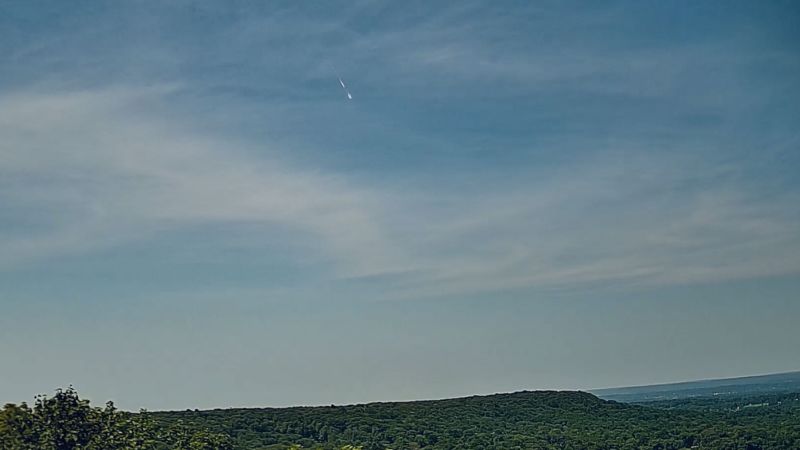Mark K.
A rare fireball was captured on video streaking through the daytime skies over Northford, Connecticut on Tuesday.
Sign up for CNN’s Wonder Theory science newsletter. Explore space with news of fascinating discoveries, scientific advancements and more.
CNN
—
A meteor bright enough to be seen in broad daylight streaked across the sky on Tuesday morning, catching the attention of several East Coast residents who recorded their sightings.
A fireball is defined as a meteor. Brighter than VenusThe meteorite is estimated to have passed over New York City, then taken a short path southwest before breaking up about 31 miles (50 kilometers) above Mountainside, New Jersey, said Bill Cook, director of NASA’s Meteoroid Environment Office.
Cook said the meteor was about a foot (0.3 meters) in diameter and would have been bright enough to be seen in the daytime. Witnessing a meteor that large is rarer than the tiny particles a few millimeters (less than an inch) in size commonly seen in the night sky.
The American Meteor Society Over 40 reports At approximately 11:15 a.m., the fireball was spotted in New York, New Jersey, Connecticut, and several other states in the northeastern U.S. The Society confirmed that two videos submitted to AMS contained footage of the fireball: one captured from a home security camera in Wayne, New Jersey, and the other from a dedicated meteor camera system installed in Northford, Connecticut.
At the same time that witnesses said they saw the fireball, several other spectators reported a loud noise and nearby shaking. Cook said the meteor can make an explosion sound as it breaks up into smaller pieces, creating “pressure waves.”
Those types of breakups could have caused the ground to shake, but NASA can’t confirm whether the meteorite’s appearance was linked to those two events because infrasound detectors used to pick up low-frequency sounds in the region were saturated by simultaneous military activity to the south, he added.
Robert Lunsford, fireball reporting coordinator for the American Meteor Society, said pieces of the meteor could survive entering Earth’s atmosphere and travel fast enough to cause a sonic boom if they reached the lower atmosphere.
“If we hear sounds coming from the fireball, this indicates that some of the debris survived into the lower atmosphere and small remnants of the original fireball may remain on the ground. These remnants are traveling at speeds much faster than the speed of sound,” Lunsford said in an email.
But because of its size and speed, the fireball broke up in the sky and likely didn’t produce a “meteorite,” the term for a meteoroid that reaches Earth, Cook said.
Cook said the last time a fireball was spotted in the area during daylight hours was about a year and a half ago.
“This is probably a once-a-year event,” he said, but added that the timing of the fireball was ideal to attract attention: “People were out for a walk, having lunch, and all of a sudden this light flashed across the sky. It was just the right place, the right time.”
If skywatchers want to see more fireballs, several meteor showers are scheduled to peak in the coming weeks: The Southern Delta Aquarids meteor shower could produce 20 meteors per hour in late July, while the Perseids meteor shower could produce more than 100 meteors per hour in mid-August, according to the Twinkle Twinkle satellite. American Meteor Society.


